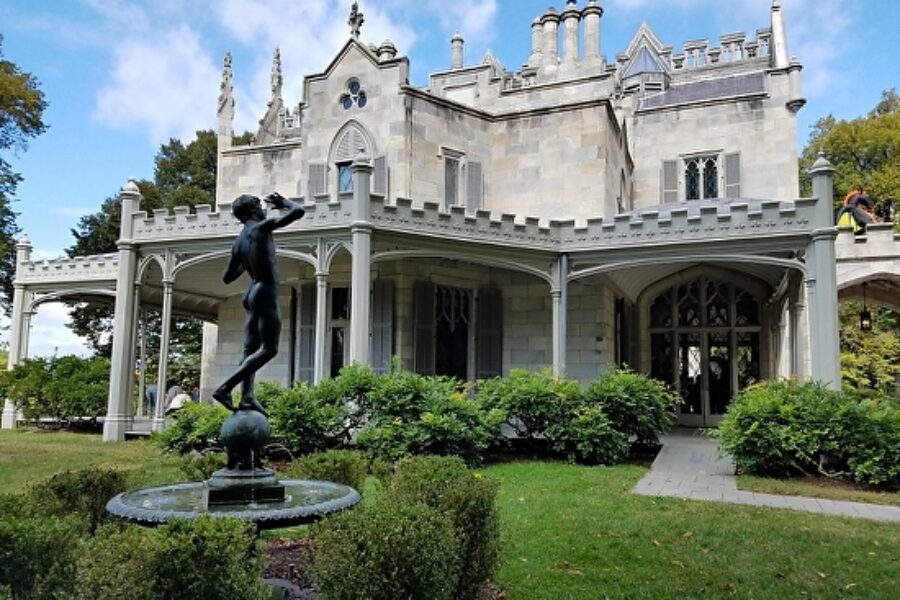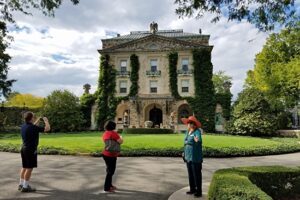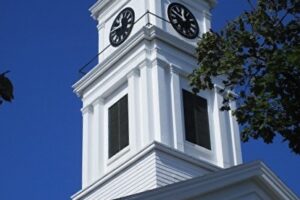A Gothic Dream
I wanted to come to Sleepy Hollow for the cemetery, but then I discovered this wonderful pile of old Gothic stone called Lyndhurst, and I knew it had to be on my list. As a young girl, Gothic Novels were among my favorite escapes from everyday reality—I would while away the hours wandering through long ago centuries with favorite heroines in magnificent estates. Lyndhurst seemed to me to embody the soul of the stories. I can just imagine Mr. Rochester’s wife locked away in the tall looming tower. It was a place I had to see.

The POD is for lunch and then a tour, but since we are here early, we decide to purchase tickets ahead of time—then have lunch. As I hand over the credit card, it is suddenly decided to start an extra tour immediately. We are a group of only six—hailing from New York, Texas, and Paris. I am not sure the Parisian wife speaks English, but her husband does, in a perfectly elegant French accent. Our guide is great—funny, entertaining, informative. The weather is beautiful. The month—WRONG!
Halloween at Lyndhurst
Being in Tarrytown, close to Sleepy Hollow, Halloween is a big thing in the area; they are decorating for the October tours. They want everything to be a surprise—no pictures. I try very hard to look past the blow-up dragon flapping his wings, and the gaudy swaths of glittery fuchsia fabric that lie draped over chairs and tables, and the red netting surrounding lights and the royal blue ode to King Arthur in the drawing-room, and the skeletons and headless horseman and pumpkins in the dining room; I concentrate instead on the history of the three families that lived here and the architecture and the faux treatment of almost every vertical surface and ceiling in the house.

Obviously, the occupants could afford the real thing—why settle for fake. The gentleman from Paris also shakes his head in wonder. “I just don’t understand,” he mutters.
Our guide explains it all away by telling us, “Merritt was showing off. It cost more to hire all of the artists to create marble walls and fake leather walls and doors made of pine to look like they were expensive grades of wood. He wanted everyone to know he was rich. It was the thing in its day.”
The house is grand and baroque and Gothic, despite the decorations. I think I would have gone for candlelight, lacy spider webs in every corner, and music from Dark Shadows—that would have been a spooky Halloween. I hope the kids love pink.



The Three Owners
Designed in 1838 by Alexander Jackson Davis, the Gothic manse was built for New York City Mayor William Paulding Jr. as his retirement home. Although he named his house “Knoll,” critics quickly dubbed it “Paulding’s Folly” because of its unusual design that included fanciful turrets rising from an asymmetrical outline. I find it very strange that Its limestone exterior was quarried at Sing Sing. I remember that name from long ago black and white movies where the bad guys would hopefully wind up—a maximum-security prison operated by the New York State Department of Corrections.
George T. Merritt, a New York business tycoon, purchased Knoll in 1864 and immediately brought in the original architect to redesign it, double the size to 14,000 square feet, design some of the furniture, and make the whole thing grand. He also renamed the house “Lyndenhurst” after the estate’s linden trees. Merritt lived in the completed fairy-tale for only eight years before his death. His widow then sold it—almost intact—to Jay Gould, a railroad tycoon, in 1880 to use as a country house. Gould shortened the house’s name to “Lyndhurst” and occupied it until his death in 1892. In total, the Gould family (two generations) lived in it for eighty-one years.

The Grounds
We escape our small group and explore the grounds on our own. The elegant park-like setting reminds me of the seemingly effortless landscape style of Capability Brown in England. Although when mentioning this to Michael, I have a hard time remembering Brown’s first name. Google has to help me out. The landscape architect hired by Merritt drained the surrounding swamps, created lawns, planted specimen trees, and built a conservatory. It was a 390-foot-long, onion-domed, iron-framed glass edifice, which was one of the largest privately-owned greenhouses in the United States when built.
The grounds are beautiful—open free to the public to wander at will—and the house is indeed grand. I hope Merritt’s friends were duly impressed.



In Search of Lunch
Before popping back into the Visitor’s Center, I search for a place to have lunch in Sleepy Hollow, instructing Google Maps to take me there.
In the visitor center, I retrieve my cherished souvenir and hand over my credit card to pay for the book on Great Houses of the Hudson River Valley. Suddenly my phone starts talking to me. I explain what is happening to the docents. Our guide of this morning tells me my choice of the Bridge View Tavern is the best in the area. Package in hand, I get in the car, and we happily proceed down the winding path.
At the restaurant, we try the door—locked. We walk around back—nothing. No one. “Don’t worry, Charlotte, I’m getting used to this. You are always taking me to closed restaurants.”
“But everyone and everything I read said, ‘come here for lunch.’” Except, apparently, on Monday’s.
We head to the less appealing, fully packed dining room of the River Grill next door.










Leave a Reply
Your email is safe with us.